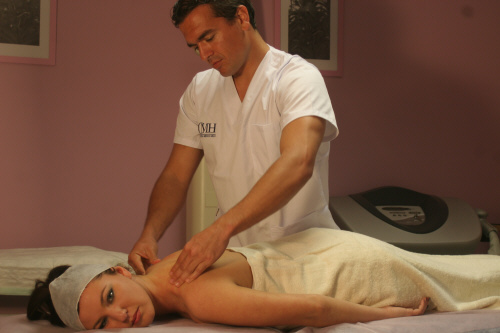 |
ALTERNATIVE THERAPIES AND TREATMENTS > Physiotherapy |
 |
Physiotherapy
is the science and technique of
treatment by physical means. The
importance of therapeutic
exercise, massotherapy and
electrotherapy. In the Hilu
Medical Centre we also include
manual and electronic tests to
determine the degree of damage
to the muscle, muscular
strength, tests to establish its
functional capacity, the extent
of the movements of the joints,
vital capacity measurements, as
well as diagnostic marks to
control progress.
The term
physiotherapy comprises the full
range of techniques in which
physical agents are used to
improve the condition of those
patients able to receive
physical treatment.
The
physiotherapist, starting with
the medical diagnosis, carries
out a preliminary evaluation of
each patient, which will consist
of a functional evaluation, and
a scheme for registering it,
together with a
physiotherapeutic record. Based
on this data some therapeutic
objectives will be formulated,
and, as, a consequence, a
therapeutic plan will be drawn
up, employing those physical
means, which are used
exclusively in physiotherapy.
Without any doubt the main tools
of the physiotherapist are his
hands, the therapy therefore is
manual.

Thus:
- Massotherapy, or the
application of different
types of massage, like
therapeutic massage, manual
therapeutic lymphatic
drainage, transverse deep
massage, cryomassage, sports
massage, myofascial
induction and liberation,
neuromuscular manual
techniques, myotensive,
connective tissue massage,
reflex massage, massage of
the periosteum, etc.
- Kinesiotherapy or
therapy using movement
- Vertebral manipulation
and manipulation of the
peripheral joints.
Orthopaedic Manual
Physiotherapy Orthopaedic or
Manual Therapy
- Mobilization: of the
joints, neuro-meningeal
manipulation, of the fascias
and viscera.
- Analytic Stretching in
Physiotherapy: Therapeutic
analytical manoeuvres in the
treatment of musculoskeletal
pathologies.
- Manual methods of
re-education of the posture,
synergies and pathological
neuromotor patterns in
Neurological Physiotherapy
- Manual methods for the
removal of obstructions in
the airways, re-balancing of
the ventilatory parameters
and breathing re-education
during effort in Respiratory
Physiotherapy.
- Hypopressive myasthenic
gymnastics and other
analytical or global
methods, to re-educate
pelvic urogynaecological
dysfunctions in Obstetric
Physiotherapy.
- Functional bandage.
- Diacutaneous fibrolysis
Physiotherapy
also uses other physical agents
and medical technology such as
electrotherapy, which is the
application of electrical
currents, ultrasound therapy or
the use of ultrasound for
treatment, pressotherapy etc.
Physiotherapy
has a place, whenever it is
medically prescribed, in the
treatment of pathological
processes in all the
specialities of Medicine and
Rehabilitation, using any of the
types of Physical Therapy
described above. The doctor is
always responsible for the
assessment, setting of
objectives and therapeutic
measures appropriate:
-
Obstetrics
and gynaecology:
Re-education pre and post
delivery, urinary
incontinence, etc.
-
Paediatrics: Infantile
cerebral palsy, obstetrical
brachial paralysis,
bronchiolitis,
arthogryposis, for, etc.
-
Vascular:
physiotherapy in amputees
using lymphatic and venous
drainage, etc.
-
Neurology: Sciatica, slipped
disc, hemiplegias, multiple
sclerosis, Parkinson’s
disease, nerve paralysis,
head injuries, medullar
lesions, etc.
-
Geriatrics: loss of mobility
and functionality of the
elderly patient
-
Pneumology: EPOC (excess
post-exercise oxygen
consumption), cystic
fibrosis, lobectomy, etc.
-
Traumatology and
orthopaedics: sprains,
fractures, luxations,
muscular tears, sports
trauma, spinal column
deviations and postoperative
recovery
-
Rheumatology: Arthrosis,
arthritis, fibromyalgia,
calcifications,
osteoporosis,
spondyloarthritis, etc.
-
Cardiology: Re-education of
exertion in patients with
cardiopathies.
-
Coloproctology: Faecal
incontinence.
-
Oncology:
Post- mastectomy
lymphoedema.
-
Haematology: Haemophilia
-
Rehabilitation
-
Physiotherapy of the patient
with burns.
-
Sport
physiotherapy
-
Others;
Psychosomatic disturbances,
stress. etc.
According to
the pathology or the lesion,
physiotherapy could be the first
choice of treatment and in
others it is of assistance in
medical or pharmacological
treatment. |